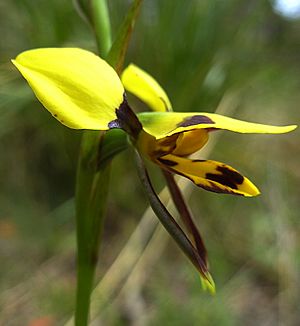Spotted doubletail facts for kids
Quick facts for kids Spotted doubletail |
|
|---|---|
 |
|
| Scientific classification | |
| Genus: |
Diuris
|
| Species: |
maculata
|
The Diuris maculata, also known as the spotted doubletail, is a special type of orchid. It only grows in New South Wales, Australia. This beautiful plant has a few folded leaves and a stem that can hold up to eight yellow flowers. These flowers have cool brown or black spots, which is how it got its name! It looks a bit like another orchid called D. pardina, but the spotted doubletail has lighter flowers with smaller spots.
Contents
What Does the Spotted Doubletail Look Like?
The spotted doubletail orchid is a plant that grows from a special underground part called a tuber (like a small potato). It lives for many years, coming back each season. It has two or three long, thin leaves that are about 15 to 25 centimeters (6 to 10 inches) long and folded down the middle.
Its flowering stem can grow to be 15 to 35 centimeters (6 to 14 inches) tall. On this stem, you'll find between two and eight bright yellow flowers, each about 2 to 2.5 centimeters (0.8 to 1 inch) wide. All parts of the flower have dark brown or black spots, sometimes even on the back!
The top petal, called the dorsal sepal, stands up or curves forward. The two side petals, called lateral sepals, hang down and cross over each other. The main petals are usually yellow with dark stalks. The bottom part of the flower, called the labellum, has three sections. This orchid flowers from July to November.
How It Got Its Name
The spotted doubletail orchid was first officially described in 1805 by a scientist named James Edward Smith. He wrote about it in his book, Exotic Botany. The second part of its scientific name, maculata, comes from a Latin word that means "spot" or "speckle." This perfectly describes the spotted look of its flowers!
Where the Spotted Doubletail Lives
You can find the spotted doubletail orchid growing in forests with lots of shrubs and in open, heathland areas. It mainly lives along the coast and in areas close to the coast in New South Wales. You might see it between towns like Taree and Eden.
How It Interacts with Other Plants and Animals
This clever orchid has a special trick! It looks very similar to the flowers of several native pea plants, like Hardenbergia violacea and Daviesia ulicifolia. These pea plants offer food (nectar) to insects.
A native bee called Trichocolletes venustus visits both the orchid and the pea flowers. The bee gets food from the pea flowers, but not from the orchid. The orchid even has special markings that only show up under UV light, just like the pea flowers do. These markings act like a "nectar guide" to trick the bees into visiting!

